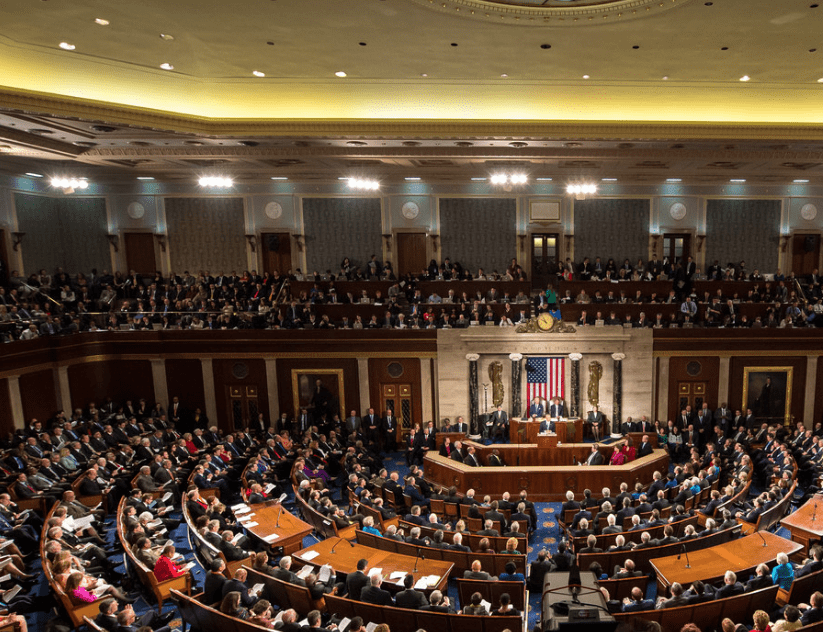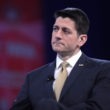I published an article here on August 22 arguing against a dangerous strategy apparently being pursued by the Clinton presidential campaign, as revealed in a hacked email discussion between DNC officials last spring. In an effort to expedite the defection of Republicans offended by their party’s nominee, the campaign was building up Speaker Paul Ryan as an exemplar of the GOP’s sensible, “normal” wing—all while wedging off Donald Trump as a dangerous exception to Republicanism past. I said this violated a sterling principal of sound politics: when your opponent—in this case the Republican Party—is drowning, you throw them an anvil, not a life raft.
At the time, I had no idea the Clinton campaign was busy inflating that very life raft. On August 25, Clinton’s strategy came to the fore. In a speech in Nevada, she officially anointed Ryan as the exemplar of the Republican Party’s sensible, “normal” wing, sidelining Trump as the dangerous (“alt-right”) exception. All this, of course, was intended to expedite the defection of Republicans offended by their party’s nominee.
The speech, I was dismayed to discover, proved quite popular among liberals, some of whom singled me out for not understanding the sublime cleverness of the “off-ramp” Clinton had provided for indignant Republicans. After all, the person who wins the most votes wins the presidential election. (I know, I know, Mr. Gore, I mean usually wins the presidential election.) Additionally, a president with more friends in Washington has a better chance of advancing her agenda than one with fewer friends—and that, simply, was all Clinton’s speech was about.
But it’s not so simple. For decades, the Democrats’ Achilles’ heel has been an obsession with strategizing to win this election, often at the expense of building strategic capacity to keep winning elections and control the agenda for the next several elections—and decades—to come.
Conservatives have always been better at that. “Hell, the catacombs were good enough for the Christians,” National Review publisher William Rusher intoned after Richard Nixon sold out conservatives at the 1960 convention, and sent them hunkering down once more for the long term. Four years later, organizing sedulously, they managed to nominate Barry Goldwater. They did not retreat after Goldwater’s landslide defeat; instead, they set to laying the groundwork for Reagan 16 years later. The annals of conservatism are replete with 30-year plans, self-described “Leninist” strategies, and campaigns to lard the federal bureaucracy with stealth conservatives and the law schools with quiet ideologues disciplined enough to keep their records clean from embarrassing pronouncements that might sour Senate judicial confirmation hearings long in the future.
Democrats, meanwhile, are just glad to pull off the next presidential election. The fact that the presidential victory is often followed by an agenda-crushing defeat two years later always comes as a surprise.
This year, we see the same short-term thinking in the celebration over the Republican apostates pledging their hearts to Hillary.
The latest Republican big fish to go Clinton is James Glassman, the George W. Bush Institute’s founding executive director. He’s also the con man who co-authored the book Dow 36,000. The paperback version came out shortly before the 2001 recession, just in time to tank the portfolios of the credulous who believed his buncombe that “Stock prices could double, triple, or even quadruple tomorrow and still not be too high.” Even so, Glassman was able to catapult from bestseller lists to the editorship of the online business site, Tech Central Station, which specialized, reporter Nick Confessore explained in 2003, in taking “aggressive positions on one side or another of intra-industry debates.” Which side it took depended on the interests of the Washington PR and lobbying firm that owned the site.
Because conservatism is fundamentally corrupt, Glassman was rewarded with the editorship of the American Enterprise Institute’s magazine, where he helped pump up the housing bubble with arguments for George W. Bush’s “ownership society” that home-buying should be made easier and that taxes on dividends must be cut. As he wrote in 2005: “People who own stocks and real estate—who possess wealth of their own—have a deeper commitment to their community, a more profound sense of family obligation and personal responsibility, a stronger identification with the national fortunes and a personal interest in our capitalist economy. (They also have a greater propensity to vote Republican.)”
For his slithering service, Bush named him his Undersecretary of State for Public Diplomacy and put him in charge of selling the glories of the American way of life to the Middle East. After Bush’s second term ended, Glassman snagged his current position as executive director of the George W. Bush Institute.
But what’s the harm? Don’t right-wing grifters’ votes count the same as horny-handed tillers of the soil? Won’t the news that famous Republicans are breaking for Hillary help ordinary Republicans stomach the switch, too? It’s not like Glassman is going to be her treasury secretary. Democrats have an election to win, and it’s less than two months away—doesn’t Team Clinton want to pile up as many supporters as it possibly can?
The flaw in this argument is that it overlooks something: the potential problems come in the longer term. Large numbers of supporters of only glancing or provisional commitment to your governing agenda, shoehorned into your tent in time for Election Day, can become quite the liability for effectuating that agenda when it comes time to govern.
Just ask Jimmy Carter.
Carter was elected president in 1976 by riding a wave of disgust with untrustworthy government, a victory foreshadowed in 1974 by the election of a passel of what became known as Congress’s “Watergate Babies.” Many of these fresh-faced political youngsters retired as legendary liberal lions: Representatives George Miller and Henry Waxman, Senators Tom Harkin and Chris Dodd. A lot of them, however, were explicitly like Gary Hart. As I wrote in my book on the period, The Invisible Bridge:
Hart was the rock star of the 1974 Democratic candidates. . . . His outmaneuvered opponent, the once-popular two term conservative incumbent Peter Dominick, said he seemed to be “trying to get to the right of Attila the Hun. . . .” His stock speech, “The End of the New Deal,” argued that his party was hamstrung by the very ideology that was supposed to be its glory—that “if there is a problem, create an agency and throw money at the problem.” It included lines like, “The ballyhooed War on Poverty succeeded only in raising the expectations, but not the living conditions, of the poor.” That was false: the poverty rate was 17.3 percent when LBJ’s Economic Opportunity Act was enacted in 1964 and 11.2 percent as Gary Hart spoke. But such claims did speak to the preconceptions of people whom Hart claimed must become the new base of the Democratic Party: the affluent suburbs, whose political power had been quietly expanding through 1960s via redistricting and reapportionment. He called those who “clung to the Roosevelt model long after it had ceased to relate to reality,” who still thought the workers, farmers, and blacks of the New Deal coalition were where the votes were, “Eleanor Roosevelt Democrats.” He held them in open contempt.
The 1976 elections brought even more not-so-liberal Democrats to Capitol Hill, while in the White House, Jimmy Carter wore contempt for the pet causes of the Eleanor Roosevelt-types (Keynesian deficit spending, unions) on his sleeve.
All in all, it was a complicated, transitional time in the history of the party. Carter also came into the White House pledging fealty to some ambitious liberal goals: a landmark full-employment bill that would include government jobs programs to bring the adult unemployment rate down to a target goal of 3 percent;[*] national health insurance; a law making it easier to join a union and harder for bosses to get away with punishing workers who did so; a federal agency devoted to advocating for consumers.
When the 95th Congress convened in January 1977, with 292 Democrats and 143 Republicans in the House and only 38 Republicans in the Senate, the universal presumption was that all of Carter’s initiatives would pass. None of them did.
There were many reasons for this. One of them was because Jimmy Carter simply didn’t want some of these laws to pass: that was the case for the full-employment measure. He nominally supported it because his advisers told him he had no choice if he wanted to remain a credible leader of the Democratic Party, as was the case with labor-law reform. He was foursquare for the consumer agency, however. He was even more passionate—it was his favorite campaign promise—about passing a progressive reform of the tax code.
In the end, each failed more miserably than the last. The Humphrey-Hawkins Full Employment bill “passed”—in a form so eviscerated that it earned the nickname the “Humphrey-Hawkins-Hatch” bill, after conservative Republican freshman Orrin Hatch, who successfully gutted it with amendments. Consumer agency and labor-law reform fell to what were at the time the most aggressive corporate lobbying campaigns in history.
The tax-reform story was the most extraordinary of them all. In January 1978, Carter announced his ambitious plans to revise the tax code in order to make the rich and corporations pay their fair share. He was delivering on his most aggressive campaign promise: he would fix a tax code that he called, on just about every stop on the campaign trail in 1976, a “disgrace to the human race.” Ninety-six percent of the population would have seen benefits from the reforms he proposed. Drafting off their shocking success scuttling the consumer and labor bills, the right wing doubled down. Republicans introduced a radical reduction in corporate tax rates, promising the loaves-and-fishes deception that would become so familiar in the Reagan years—that the benefits would trickle down to enrich all Americans.
It didn’t even take Reagan’s election to get there. In October 1978, a Congress with more than two-to-one Democratic representation voted for the first time in history to make the tax code more regressive. In each of the progressive measures that was defeated, the deciding votes came from first- or second-term Democratic congressmen. The reason for this poor fortune for the New Deal legacy, paradoxically, was precisely what was understood to be the good fortune of the Democratic Party: habitual Republicans disgusted with their party after Watergate were voting for Democrats for the first time. Many of the Watergate Babies represented traditionally Republican suburbs. They went to Washington and voted their constituencies. It was one of the reasons—though there were many—that Jimmy Carter geared up to run for his second term with the albatross of a failed presidency around his neck.
The parallel to Hillary Clinton is partial, of course. If she wins, there will almost certainly be a Republican majority in the House of Representatives, not a Democratic supermajority. Unlike Jimmy Carter, all evidence—despite what the conspiracy theories of Hillary-haters on the left suggest—points to her as a politician who is publicly committed to a far more Rooseveltian vision of the economy. In a little-covered speech in August to the Detroit Economic Club—an audience of business people, as New York magazine reported—she “reiterated her opposition to the TPP in the strongest terms she’s ever used on that subject,” and “called for a public health-care option in all 50 states, free public-college tuition for the middle class . . . and paid family leave.”
Yet, as Politico reported, Team Clinton was simultaneously pursuing “a behind-the-scenes recruitment effort that’s been months in the making,” winning over Republicans disgusted by Trump, like failed Hewlett-Packard CEO and California gubernatorial candidate Meg Whitman, and Matt Higgins, former press secretary to Rudy Giuliani and McCain 2008. Leslie Dach, a former executive at Walmart (which just happens to be the most savagely anti-union corporation in America), has headed these outreach efforts since last spring. Was Dach vetted for her accord with the position, as Clinton put it in the Detroit speech, that “strengthening unions doesn’t just serve members, it leads to better wages and working conditions for all employees”? Would Higgins, the Giuliani flack, feel comfortable in a room with the Mothers of the Movement, the collective of mothers of victims of police violence who spoke so eloquently at the Democratic National Convention? Does the executive director of the George W. Bush Institute expect Clinton to aspire to the sterling example of George W. Bush’s public-policy accomplishments, in exchange for the votes Glassman intends to deliver?
I wish I saw evidence that Team Clinton even cared about these concerns. As a campaign senior strategist said, “Campaigns are always looking for ways to build your coalitions of voters. To the extent we can add to that by appealing to some moderate Republicans and some Republican-leaning independents—that’s worth some energy. It’s not going to consume the campaign, but it is worth the energy.” You know when it’s not worth the energy? When it weakens your party in the long term.
Or, if it attenuates the coalition of legislators on Capitol Hill that will be needed to get done what Hillary Clinton says she wants done—if not in 2017, perhaps in 2019, when a Democratic House majority might be within more realistic reach. That was the fear expressed by the DNC’s communication director in the May 2016 email I wrote about in August: efforts “to embrace the ‘Republicans fleeing Trump’ side, but not hold down ballot GOPers accountable” might be great for getting more votes for Clinton, but these come at the price of fewer wins for Democratic congressional candidates.
What might pose even greater danger is success: if the Clinton people are right and Democrats up and down the ticket harvest greater-than-expected dividends with a “we’re not Trump, come on in, normal Republicans, the water’s fine!” message. Politicians are greedy and short-sighted, almost always placing electoral victory ahead of long-term legislative accomplishment. If Democratic congressional candidates outperform their own expectations and attribute their success to cross-over voters who are ideological twins of the Higginses, Glassmans, and Whitmans, once in office they may work to hold on to those voters.
If that happens, here is an all-to-predictable eventuality for 2018. Political parties are greedy, too, and it’s not a stretch to imagine that the party could begin recruiting candidates who “build your coalition of voters” by “appealing to some moderate Republicans and some Republican-leaning independents.”
As I’ve written, we have been down that sad road before. In 2006, Rahm Emanuel, then head of the Democratic Congressional Campaign Committee, “aggressively recruited right-leaning candidates, frequently military veterans, including former Republicans.” Democrats won the battle, taking the House back from the Republicans for the first time since 1994. But they lost the war:
The 2007 majority proved to be a rickety one. Critics argue that, even where Emanuel’s strategy succeeded in the short term, it undermined the party over time. One of his winners, the football star Heath Shuler, of North Carolina, would not even commit to vote for Nancy Pelosi for Speaker of the House, and was one of many Rahm recruits to vote against important Obama Administration priorities, like economic stimulus, banking reform, and health care.
The adventure ended with the biggest Republican House majority since the 1920s.
People will say this is an argument for purity. It’s actually a plea for practicality. Hillary Clinton will almost certainly win the presidential election on November 8. That’s merely the battle for today, when anti-Trump votes come cheap. But this election is not just about rescuing the nation from Trump. It’s about rescuing the nation from conservatism. That’s the long march. It cannot be won with conservatives in tow.
Rick Perlstein is The Washington Spectator’s national correspondent.
[*] Correction: This sentence has been revised to clarify that the goal of the full-employment bill was to bring unemployment down to 3 percent, not to create “a government jobs program if unemployment fell below three percent,” as originally stated.







Overall a good article which makes it incomprehensible to me how it could be so naive as to cite the claim that Hillary is genuinely anti-TPP, for a public option, free public education and paid family leave. Those are just 4 more issues where she aped Sanders positions when it was time to pander to his supporters the “left” that you dismiss as “haters”. And a Clinton speaking in an election year to boot? How can you be so naive as to buy into empty election-year rhetoric, especially from someone with such a solid track record of selling out constituencies when it’s politically expedient?
Unlike Jimmy Carter, all evidence—despite what the conspiracy theories of Hillary-haters on the left suggest—points to her as a politician who is publicly committed to a far more Rooseveltian vision of the economy.
Compared to what? She comes from the DLC/Third Way wing of the party remember.
Another way to look at this is that Clinton is playing to her true ideological center. During the primaries, some of us (i.e., Sanders voters) saw the race as a choice between the ‘FDR wing’ of the party and the ‘Rockefeller’ wing represented by the Clinton/Obama neoliberals. Clinton has made some moves to placate Sanders supporters, but her heart is not in it when it comes to issues like campaign finance reform, wall street regulation, and fighting ‘trade’ deals that bolster corporate power (the very deals she worked for as secretary of state). She is comfortable taking advice from the war criminal Henry Kissinger. She speechifies about getting money out of politics, then goes right back to closed-door private fundraisers with wealthy donors. You can complain about conservatism being inherently corrupt, but until the Democrats deal with the dark stain at the center of their own party, they’ll continue to be dysfunctional.
Leslie Dach is male, not female, unless Rick Perlstein knows something that nobody else does.